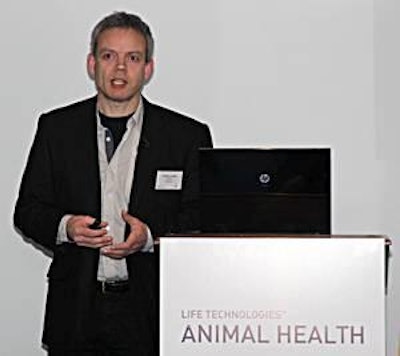
The better the information, the better the decision. In an era when poultry producers are living with tight margins and greater restrictions on the use of veterinary medicines, taking the correct course of action has become central to maintaining profitability. Knowing with certainty what is happening in the flock, rather than relying on a degree of guesswork, can give producers an advantage that was not easily available in the past.
And this is where modern diagnostic technologies can play a part. The benefits that advances in diagnostics can bring to food animal producers was among the topics of a meeting in Brussels late last year entitled "Advances in Diagnostics," sponsored by Life Technologies Animal Health.
Speaking at the event, Dr. Willie Loeffen, president of the European Association of Veterinary Laboratory Diagnosticians, said: “Technological developments mean that diagnosticians can now do things that they could only dream about 10 years ago. Laboratory diagnosis used to be 99 percent labor and 1 percent technology; nowadays, the emphasis is the other way around. Technology is now an integral and indispensable part of veterinary laboratories.”
Additional tool
Kirk Adams, director of product management, Life Technologies, noted that veterinarians have always used all of their senses to make a diagnosis. On going into a broiler house, he noted, you check the litter, and a veterinarian will always do this, but more tools are available to make a diagnosis. “Now, we can look at almost any pathogen, and this will revolutionize the way that animals are reared,” he said.
Many diseases have the same clinical signs, so there is always the risk that treatment decisions are based on the belief that one causative agent is present when, in fact, a flock is infected with another. Relying on the senses may often work, but with rapid and accurate diagnostic tools, a poultry veterinarian can be sure of a correct diagnosis and, with proper interpretation of results, recommend the correct treatment.
Adams added: “Diagnostics are no longer just a way of finding out what an animal died of; they have a multitude of uses on farm. They mean that we can take a more holistic and proactive approach to animal health; in contrast to the reactive, disease driven approach of the past.
“As just one example, better diagnostics allow a more targeted approach to treatment and the potential to reduce the use of broad-spectrum drugs, such as certain antibiotics, and thus comply with the wishes of consumers and legislators.”
Greater use of diagnostics in flock or herd health could result in better vaccination programs and improve biosecurity, as well as helping in disease eradication schemes and improving disease status by identifying persistent infection and asymptomatic birds or animals. They also allow veterinarians to monitor flock health, which aids in building up an accurate and dynamic picture of health status and risk profile, as well as screening for emerging diseases.
Adams continued: “The next 20 years could see the biggest change in the way we manage production animals in over a hundred years.”
Greater security
While employing diagnostics on the farm may offer more predictable performance and productivity, there has been the issue of the time taken to receive results and cost of diagnosis. Yet these issues have changed dramatically over recent years and continue to change.
Illustrating this change, Loeffen pointed to the human genome project, and how its completion took 12 years at a cost of US$3 billion. The same results could be obtained now in under two hours and at a cost of US$1,000.
Accurate diagnosis not only allows you to know which treatments or vaccinations should be chosen, but knowing a flock’s health status also gives greater insight into who can and cannot be allowed on farm. Developments in molecular technology mean that it is possible to understand disease and health at a deeper level than ever before at the gene level, and that will have a major impact on the way that animal health and welfare are approached.
Adams continued: “In the future, we will be able to use gene sequencing to determine the sensitivity of individual animals to specific treatments. Molecular tests, such as polymerase chain reaction, also facilitate disease eradication programs, more strategic use of vaccination, more effective biosecurity measures and the management of diseases for which there is no effective treatment by allowing the identification of asymptomatic, persistently infected animals. There are many ways in which this technology can and will be applied to improve the health and productivity of food animals.”


















